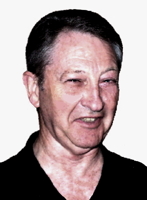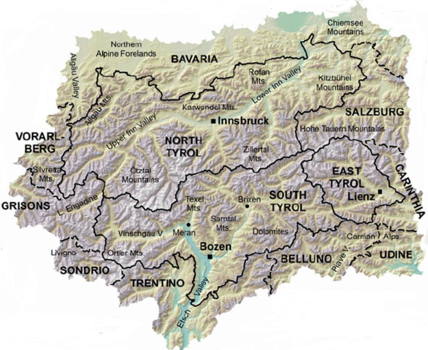
|
The Society of Folk Dance Historians (SFDH)
Dance and Folklore of the Tyrol
[
Home |
About |
Encyclopedia | CLICK AN IMAGE TO ENLARGE |

|
The Tyrol (or Tirol) is that part of Europe surrounding the beautiful Alpine Mountains of southern Germany and Austria. Though historically Germany and Austria were frequent battlefield adversaries, the Tyrol appears as a homogenous area with compact settlements nestled in picturesque valleys and an economy based on a dairy and cheese-making industry. To be sure, there are obvious differences between the Bavarian and Austrian cultures in the Tyrol.
Simply stated, German music and dance appear more regimented and aggressive; music is played frequently with brass bands and a strong marching tempo. Austrian music is frequently softer, slower, more melodic, and played on a single zither or other stringed instrument.
German immigrants made a major contribution character of those who founded America. Their work ethic, concern for craftsmanship, and talent for producing high quality goods set an example for those whom they joined in the mix of cultures that became Americans. Even today, German craftsmanship and engineering remain the standard for others to follow.
In any society, the dance produced by that culture reflects the values and aesthetics of those who created it. The dances of Germany are no exception. In the industrial north, home to huge manufacturing enterprises, the most common dance form is the set dance, frequently in quadrilles executing intricate and charming figures requiring well-coordinated movements by every dancer – just in a piece of complex machinery. Sauerlander Quadrille is one well-known example.
To the south, in the mountainous Bavaria, the people are much closer to nature. The splendid scenery and bracing mountain air lend to an outdoor life and the Bavarians do it with serious zeal. As one might expect, their most popular dance, the Schuhplattler, mimics not machinery but wildlife, the "aurhan," the famous ring-tailed wood grouse. As large as a small turkey, the aurhan cock preens and struts in front of the hen, frequently on a fallen log, beating his wings to create a rhythm to impress the object of his lust. It works when the hen responds by turning in circles before him. The Schuhplattler does the same thing.
The men's dance consists of a syncopated series of very loud stamps, hand claps, and slaps on lederhosen-clad thighs and soles of the shoes (thus "schuhplattler" or "hitting the shoe"). Every district has its own unique plattle (slapping rhythm), many of them very complex, all requiring strength, flexibility, and stamina. Couple plattles are usually danced in 3/4 meter. Absolute precision is required, each slap, clap, and stamp heard as one, regardless of the number of dancers.
As the men plattle, the women turn in a never-ending "dreher" or spin, either traveling around the men or remaining in place. Again, different regions have different footwork, either stepping on counts 1 and 3 or a half turn on every beat; both are one of the more difficult dance techniques for a woman to master. Any time she is not dancing with her partner, the woman's skirt must be fully belled out. Between plattles, the men pursue, capture, and waltz with their partners – in obvious mime of nature.
Annual contests, called "gaufests," pit schuplattler performing groups from across the country in a schuhplattler marathon. Groups draw lots to determine which one of three different plattles they will perform: Haushammer, Hitauer" or Reit im Winkle. Each group must have all three plattle performances competition-ready. The competition is strict and intense. Total unity within the group is paramount: arms must all be at the same angle and height, feathers in hats must be at the same angle. Women must turn at the same rate, skirts must be belled, five men plattling must sound like one only defeningly louder. It even helps if the dancers are all close to the same size and height. There's not a smile anywhere. Each group is free to create their own choreography within the structure of the plattle and design its own costumes, but every dancer must look and move just like the others, with no one individual identifiable from the rest. (There is an interesting similarity to the Scottish Country Dance.)
So, in the Schuhplattler we see the expression of the Bavarian's close ties with nature, their concern with precision and power – and the dour German personality with which they perform this wonderful dance.
The Austrian Schuhplattler is generally danced with the women wearing a longer skirt that precludes the belled-out appearance of the Bavarians. Plattles are generally slower and rhythms can be more complex, as allowed by the slower tempo.
The Ländler is another major folk dance of the Tyrol and is found as far south as Switzerland and as far east as Bohemia. Characterized by complex intertwining of the couple's arms, changing continuously into seemingly impossible contortions, the Ländler represents closeness in the relationship between men and women. The Zillertaller Ländler in the folk dance repertoire is a simplified version from the Zillertal Valley of Austria. Other versions are found in many of the Bavarian dances performed at Okboberfest, though the Bavarian versions are somewhat faster and less complex.
The Zwiefacher translates as "two things" in reference to its mixed 2/4 and 3/4 meter; the dance consists of drehers (pivot turns) and waltz turns, couples in a close dance position in a continuous spin. The combinations of dreher (D) and waltz (W) range from simple (WWDD) to a challenging combination that will test the skill of any dancer. The Zwiefacher is found throughout the Tyrol, Switzerland, Czech Republic, and into the Black Forest in Germany and Alsace, a cultural and historical region in eastern France, though with regional characteristics and even different names.
The Rhineländer is the name for the Schottische throughout Europe in reference to its place of origin in the Rhineland, Germany. Most folk dancers are familiar with the basic Schottische and the variants danced in Scandinavia, France, and elsewhere are endless and challenging.
The Polka is probably the most widely known of all European folk dances. First recorded in Bohemia in the mid 1830s, the dance was popular in the California Gold Rush country some 15 years later and is danced in one form or another in most of Western Civilization even today. It is the national dance of the Czech Republic, where it is danced with wonderful variations and lovely Czech polka music. Oktoberfest bands play one polka after another for hours. The polka's quick popularity in the mid-1800s in Europe was largely responsible for the widespread acceptánce of couple dance in polite society, breaking generations-old resistánce to such intimate displays.
Tradesmen's dances, frequently danced in 2/4 meter, frequently utilize implements and tools of the trades. Holzhackerbaum (logger's plattles) use a log, cross-cut saw and axes, making a lovely mess of the dance floor with sawdust and wood chips flying everywhere. Knappentánc (miner's dances) use a large rock, hammers and various-sized chizels; similarly, Ambosstánc (blacksmiths's dances) use an anvil and various-sized hammers to create melodies. Muehlradl (baker's dance) mimics the gears and paddles of the bread dough-mixing machine. Benches, staffs, and other props are frequently used in plattles where men play tricks on one another and even stage mock fights in the Watchentánc.
There are countless additional examples of dance traditions from the Tyrol, many only performed in isolated villages, many only on special occasions. The wealth of Tyrolean folklore would occupy the life's work of many scholars – and has!
So, the lovely Tyrol has much more to offer than dazzling mountain landscapes echoing with lonely yodeling by lonesome herdsmen. The folklore of this region rivals that of any in the richness and complexity of its traditional folk arts, music, and dance.
DOCUMENTS
- Austria, a country.
- Austrian Dance, an article.
- Choreogeography: Bavarian Schuhplattler, an article.
- Dave Rosenberg, teacher.
- Germany, a country.
- Morry Gelman, teacher.
- Richard Duree, an article.
- Schuhplattler, a dance family.
Used with permission of the author.
Printed in Folk Dance Scene, October 2009.
This page © 2018 by Ron Houston.
Please do not copy any part of this page without including this copyright notice.
Please do not copy small portions out of context.
Please do not copy large portions without permission from Ron Houston.
